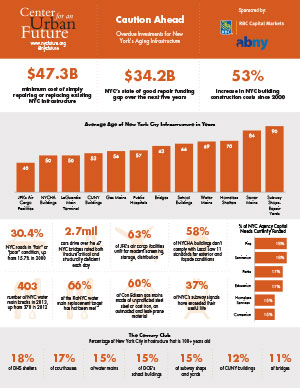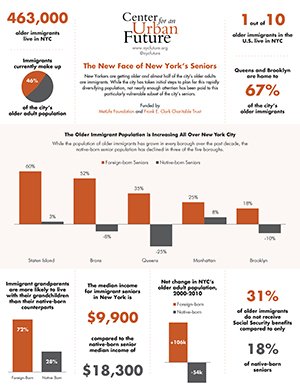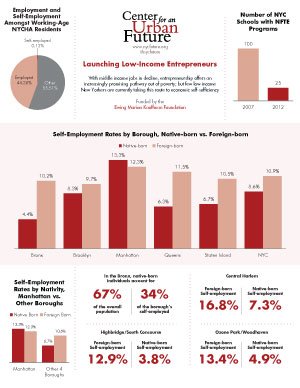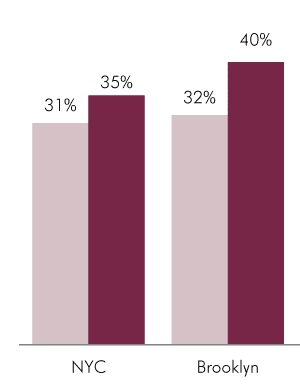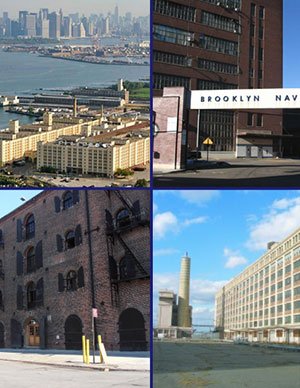boroughs
Impact - May 2014
Mayor’s plan to upgrade Brooklyn Army Terminal echoes CUF recommendationsMayor de Blasio's plans to redevelop unused space at the city-owned Brooklyn Army Terminal echoes a recommendation made in the Center's "The Final Frontier for Manufacturers" report.
Data - March 2014
Data from Caution AheadCharts and tables from our Caution Ahead report which found that while Superstorm Sandy focused much-needed attention on key pieces of New York City’s infrastructure, the city faces a number of other infrastructure vulnerabilities that have little to do with storm-preparedness—from aging water mains and deteriorating roads to crumbling public schools. If left unchecked, they could wreak havoc on the city’s economy and quality of life.
Data - July 2013
Data from The New Face of New York's SeniorsSelected charts and tables from the Center for an Urban Future's 2013 report The New Face of New York's Seniors. The report found that New Yorkers are getting older and almost half of the city’s older adults are immigrants; but while the city has taken initial steps to plan for this rapidly diversifying population, not nearly enough attention has been paid to this particularly vulnerable subset of the city’s seniors.
Impact - July 2013
CUF Influences MTA’s Needs Assessment for NYC Transit SystemIn July 2013, the MTA published a forward-looking needs assessment for New York City’s transit system that was greatly influenced by the Center's Behind the Curb study.
Data - July 2013
More than ManhattanManhattan remains the epicenter of New York City’s economy, but the other four boroughs now comprise roughly 40 percent of all private sector jobs in the city, their highest total ever. In 2012, Manhattan accounted for 60.50 percent of the city’s private sector jobs, down from 65.92 percent in 1982 and 63.08 percent as recently as 2000.
Data - April 2013
Data from Launching Low-Income EntrepreneursSelected charts and graphs from the Center for an Urban Future's major April 2013 report on low-income entrepreneurs. The report found that with middle-income jobs in decline, entrepreneurship offers an increasingly promising pathway out of poverty; but few low-income New Yorkers are currently taking this route to economic self-sufficiency.
Impact - April 2013
CUF Influences Speaker Quinn’s New Transportation ProposalsCity Council Speaker Christine Quinn announced a series of new proposals to improve mass transit in New York City. Three of the proposals were influenced by our 2011 Behind the Curb report which found that New York City’s public transit service has not kept pace with recent job growth and transit ridership gains.
Data - April 2013
Low-Wage Jobs, 2012Over the past five years, the number of New Yorkers who work in low-wage jobs has steadily increased, with more than a third of adults in the city—and nearly half in the Bronx—now stuck in low-paying occupations.
Impact - April 2013
CUF Report About NYC's Libraries Sparks New Proposal From Speaker QuinnCity Council Speaker Christine Quinn announced a new proposal to harness the incredible power of New York City's branch libraries. The proposal was sparked by our January 2013 Branches of Opportunity report about the increasingly important role that the city's public libraries are playing in communities around the five boroughs.
Data - March 2013
Is Manufacturing Back in Brooklyn?Like the rest of New York City, Brooklyn has been bleeding manufacturing jobs for decades. But in the last few years, manufacturing employment in the borough is up slightly, even though the average company now has considerably fewer employees on average. Is Brooklyn in a new age of entrepreneurial manufacturing?


